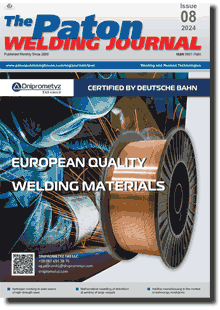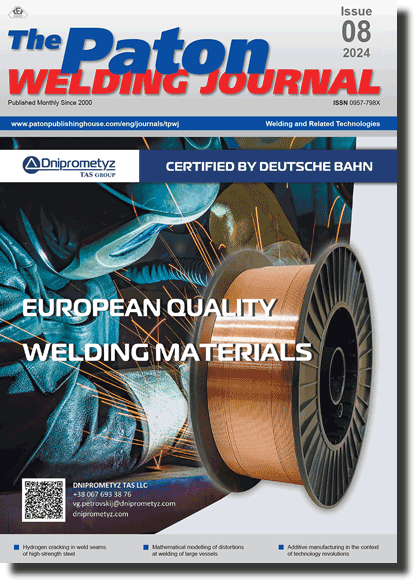Access for download PDF files for subscribers and for reviewers of scientometric bases.
Organization: Elsevier for content access(PDF files of journals released before 2024 are available for download from the website's archives))
Organization: Elsevier for content access(PDF files of journals released before 2024 are available for download from the website's archives))
| 2024 №08 (06) |
DOI of Article 10.37434/tpwj2024.08.01 |
2024 №08 (02) |

The Paton Welding Journal, 2024, #8, 3-9 pages
Challenges for testing hydrogen-assisted cold cracking in weld seams of high-strength steel grades
M. Rhode1,2, T. Mente1, T. Kannengießer1,2, T. Schaupp3, A. Zavdoveev4
1Bundesanstalt für Materialforschung und -prüfung (BAM), Berlin, Germany, E-mail: michael.rhode@bam.de2Otto-von-Guericke University, Magdeburg, Germany
3SPC Werkstofflabor GmbH, Westhausen, Germany
4E.O. Paton Electric Welding Institute of the NASU 11 Kazymyr Malevych Str., 03150, Kyiv, Ukraine
Abstract
Hydrogen can cause weld cold cracking even days after fabrication. In this respect, higher strength steels present a challenge to established cold crack testing. In general, the tolerable hydrogen concentration for crack prevention decreases with increasing material strength. In addition, advanced welding processes require changes in weld geometry and heat input. This directly influences the formation of crack-critical microstructures, e.g. in hardened areas of the heat-affected zone. The limits of use and application of modern cold cracking tests are evaluated by (1) the externally loaded Implant-test and (2) the self-restraint Tekken-test. In particular, external mechanical stresses, which cause additional mechanical loads on the components during welding, must be considered due to the component-specific stiffness of high-strength steels. Accompanying test methods for determining hydrogen concentration and diffusion in welds are presented, such as carrier gas hot extraction for determining hydrogen concentration (ISO 3690) or temperature-dependent diffusion coefficients. These values are of great importance for a holistic approach to the evaluation of the cold cracking sensitivity of high strength steels.
Keywords:hydrogen, cold crack, test, welding, high-strength steel
Received: 21.05.2024
Received in revised form: 09.07.2024
Accepted: 26.08.2024
References
1. Gliner, R.E. (2011) Welding of advanced high-strength sheet steels. Weld. Int., 25(5), 389-396, 2011. https://doi.org/10.1080/09507116.2011.5542342. EN 1011-2:2001: Welding - recommendations for welding of metallic materials.
3. Villalobos, J.C., Del-Pozo, A., Campillo, B. et al. (2018) Microalloyed steels through history until 2018: review of chemical composition, processing and hydrogen service. Metals, 8(5), 351. https://doi.org/10.3390/met8050351
4. Zhang, L., Kannengiesser, T. (2016) HAZ softening in Nb-, Ti- and Ti+ V-bearing quenched and tempered steel welds. Weld. World, 60(2), 177-184. https://doi.org/10.1007/s40194-016-0299-7
5. Grabke, H.J., Riecke, E. (2000) Absorption and diffusion of hydrogen in steels. Mater. Technol., 34(6), 331-342.
6. Zimmer, P, Seeger, D.M., Boellinghaus, T. (2005) Hydrogen permeation and related material properties of high strength structural steels. In: High strength steels for hydropower plants. Verlag der Technischen Universität Graz, Austria, 17, 1-18.
7. Schaupp, T., Rhode, M., Yahyaoui, H., Kannengiesser, T. (2020) Hydrogen-assisted cracking in GMA welding of highstrength structural steels using the modified spray arc process. Weld. World, 64, 1997-2009. https://doi.org/10.1007/s40194-020-00978-0
8. Schaupp, T., Rhode, M., Kannengiesser, T. (2018) Influence of welding parameters on diffusible hydrogen content in highstrength steel welds using modified spray arc process. Weld. World, 62(1), 9-18. https://doi.org/10.1007/s40194-017-0535-9
9. Kannengiesser, T., Boellinghaus, T. (2013) Cold cracking tests - an overview of present technologies and applications. Weld. World, 57, 3-37. https://doi.org/10.1007/s40194-012-0001-7
10. ISO 17642-1:2004: Destructive tests on welds in metallic materials - Cold cracking tests for weldments - Arc welding processes. Pt 1: General.
11. ISO 17642-2:2005: Destructive tests on welds in metallic materials - Cold cracking tests for weldments - Arc welding processes. Pt 2: Self-restraint tests.
12. ISO 17642-3:2005: Destructive tests on welds in metallic materials - Cold cracking tests for weldments - Arc welding processes. Pt 3: Externally loaded tests.
13. ISO 3690:2018: Welding and allied processes - Determination of hydrogen content in arc weld metal.
14. Kromm, A., Thomas, M., Liepold, P. et al. (2011) Influence of welding and testing parameters for hot cracking assessment of high-strength welding consumables. Fortschrittsberichte der Materialforschung und Werkstofftechnik, 12, 357-365. Shaker Verlag, Düren, Germany.
15. Rhode, M., Kromm, A., Mente, T. et al. (2024) Component test for the assessment of delayed hydrogen-assisted cracking in thick-walled SAW joints for offshore applications. Weld. World, 68, 621-634. https://doi.org/10.1007/s40194-023-01658-5
16. Tasak, E., Ziewiec, A., Adamiec, J.A. (2011) The role of hydrogen in weld cracking processes - a new look at the problem. Weld Int. 25(6), 409-414. https://doi.org/10.1080/09507111003655200
17. Schwenk, C., Kannengiesser, T., Rethmeier, M. (2008) Restraint conditions and welding residual stresses in self-restrained cold cracking tests. In: Proc. of the 8th Inter. Conf. on Trends in Welding, Pine Mountain, USA, 2008, 766-771. ASM International. DOI: https://doi.org/10.1361/cp2008twr766
18. Schaupp, T., Ernst, W., Spindler, H., Kannengiesser, T. (2020) Hydrogen-assisted cracking of GMA welded 960 MPa grade high-strength steels. Int. J. Hydro Energ., 45, 20080-20093. https://doi.org/10.1016/j.ijhydene.2020.05.077
19. Rhode, M., Schaupp, T., Muenster, C. et, al. (2019) Hydrogen determination in welded specimens by carrier gas hot extraction - a review on the main parameters and their effects on hydrogen measurement. Weld. World, 63, 511-526. https://doi.org/10.1007/s40194-018-0664-9
20. Rhode, M., Mente, T., Kannengiesser, T. (2024) Parameters and challenges for reliable hydrogen determination in welded joints by carrier gas hot extraction. The Paton Welding J., 4, 3-10. https://doi.org/10.37434/tpwj2024.04.01
21. Mente, T., Boellinghaus, T., Schmitz-Niederau, M. (2012) Heat treatment effects on the reduction of hydrogen in multi-layer high strength weld joints. Weld. World, 56(7-8), 26-36. https://doi.org/10.1007/BF03321362
Suggested Citation
M. Rhode, T. Mente, T. Kannengießer, T. Schaupp, A. Zavdoveev (2024) Challenges for testing hydrogen-assisted cold cracking in weld seams of high-strength steel grades. The Paton Welding J., 08, 3-9.The cost of subscription/purchase order journals or individual articles
| Journal/Currency | Annual Set | 1 issue printed |
1 issue |
one article |
| TPWJ/USD | 384 $ | 32 $ | 26 $ | 13 $ |
| TPWJ/EUR | 348 € | 29 € | 24 € | 12 € |
| TPWJ/UAH | 7200 UAH | 600 UAH | 600 UAH | 280 UAH |
| AS/UAH | 1800 UAH | 300 UAH | 300 UAH | 150 UAH |
| AS/USD | 192 $ | 32 $ | 26 $ | 13 $ |
| AS/EUR | 180 € | 30 € | 25 € | 12 € |
| SEM/UAH | 1200 UAH | 300 UAH | 300 UAH | 150 UAH |
| SEM/USD | 128 $ | 32 $ | 26 $ | 13 $ |
| SEM/EUR | 120 € | 30 € | 25 € | 12 € |
| TDNK/UAH | 1200 UAH | 300 UAH | 300 UAH | 150 UAH |
| TDNK/USD | 128 $ | 32 $ | 26 $ | 13 $ |
| TDNK/EUR | 120 € | 30 € | 25 € | 15 € |
AS = «Automatic Welding» - 6 issues per year;
TPWJ = «PATON WELDING JOURNAL» - 12 issues per year;
SEM = «Electrometallurgy Today» - 4 issues per year;
TDNK = «Technical Diagnostics and Non-Destructive Testing» - 4 issues per year.


